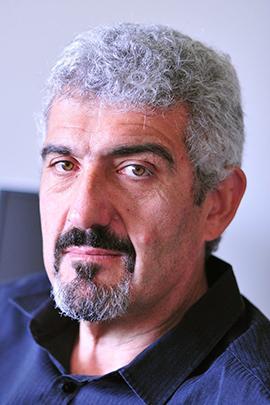Chemistry Seminar: Visiting researcher George Koutsantonis
- Date: Fri, 15 Mar 2019, 12:00 pm - 1:00 pm
- Location: MacBeth Lecture Theatre - Badger building
- Cost: FREE
- Contact: Jacqui Hull 8313 5365
- Email: jacqui.hull@adelaide.edu.au

Presenter
George Koutsantonis - University of Western Australia
University of Adelaide graduate George Koutsantonis is a synthetic chemist with an interest in functional materials that contain metals.
Abstract
Illuminating molecular electronic rectification
The semiconductor industry has acknowledged that it will abandon the pursuit of Moore’s law,1 ie. the doubling of electronic chip component density per year. Efforts to maintain pace with Moore’s Law2 have driven decades of technological achievement and new materials science in the semiconductor industry.3
However, despite IBM’s demonstration of 5 nm transistors, and Samsung’s 10 nm FinFET technology, the International Roadmap for Devices and Systems predicts the end of CMOS technology by 2024.4 Furthermore, top-down scaling is becoming breathtakingly complex, and increasingly giving way to more complex and challenging 3-D designs using extreme ultraviolet (EUV) lithography (e.g. IBM’s GAAFET Samsung’s 3nm FinFET5).
The use of molecules is seen as a way overcoming the challenges of top-down nanofabrication. Molecular electronics has the potential of alleviating the challenges confronting the conventional solid-state semiconductor.
Photochromic compounds are attractive components for molecular electronics applications as they provide light induced switching elements. They provide an alternative to gating through conformational changes to the orientation of the phenylene ring systems in bis(thiolate) contacted bis(phenyl ethynyl)benzene (BPEB) based molecular transistors. We consider alternative switching elements based on dihydropyrene (DHP), and spiropyran, (SP) as precursors to switchable molecular components.
The dihydropyrenes offer significant advantages over other photochromes in terms of their structural re-organisation between the open and closed forms, both of which are essentially linear and there is much greater scope for functionalization of dihydropyrenes. Spiropyrans are well-known photochromic molecules the SP form is typically colourless, and has a low dipole moment, which, on irradiation, converts to the more linearly conjugated merocyanine (MC), which is intensely coloured with a much higher electric dipole moment.
When compared to other classes of photochromic compounds, SPs have certain advantages, including, synthetic accessibility and wide possibilities for structural variation; high values of quantum efficiency of forward and reverse photo-initiated rearrangements; very high cross sections of two-photon light absorption of ring-opened and ring-closed isomeric forms.
The photochromic molecules tend to isomerise to the open isomer when irradiated with visible light. Back-conversion can be achieved by irradiation with UV light, or heat. In the case of dihydropyrenes, the DHP isomer is significantly more conjugated than the CPD isomer, which in turn results in the DHP being more electrically conductive. This allows switching of electric current by isomerisation.
This talk describes the synthesis and properties of SP and DHP based molecular switches. We have synthesised new 2,7-bisalkyne DHPs with internal alkyl groups (methyl, ethyl, butyl) by multistep syntheses starting from 5-triisopropylsilyl acetylene-dimethylisophthalate.
Our synthetic approaches to new SP molecules will also be discussed.
Preliminary molecular conductance results will also be presented. Here we demonstrate that the conductance of both DHP and SP molecules can be measured using STM-BJ method, providing some surprising results.
Additionally, the conductance, and indeed rectification, of current has been demonstrated in SAM based large area ensembles measured by the EGaIn methods.
References
- Waldrop, M. M. Nature 2016, 530, 144-147.
- Mack, C. A. IEEE Trans. Semiconduct. Manuf. 2011, 24, 202-207.
- Thompson, S. E.; Parthasarathy, S. Mater. Today. 2006, 9, 20-25.
- International Roadmap for Devices and Systems, https://irds.ieee.org/roadmap-2017, 2017.
- EE Times, https://www.eetimes.com/document.asp?doc_id=1333318# 2018.
